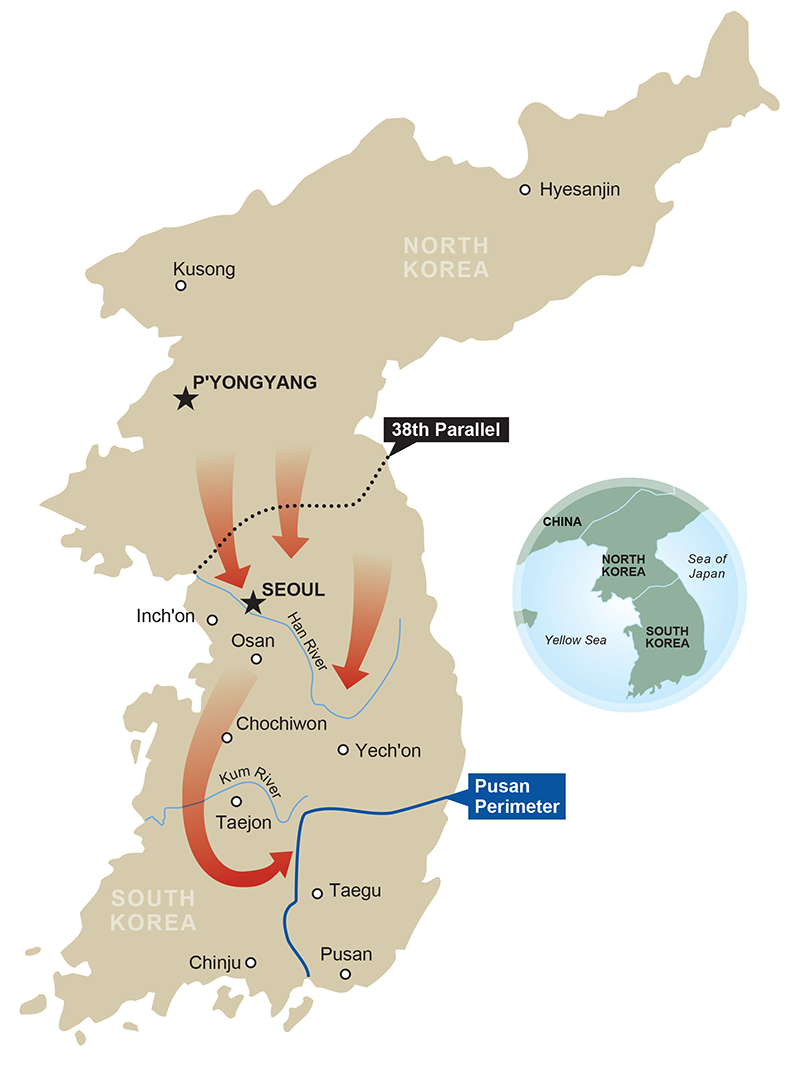
The Korean War: Phase 1
27 June-15 September 1950 (UN Defensive)
Courtesy of the Center of Military History
Republished by the USASOC History Office, August 2020
Chronology
| 25 Jun | North Korean forces cross border with South Korea. North Korean People’s Army (NKPA) numbers approximately 135,000 men; Republic of Korea (ROK) Army contains 98,000 soldiers. |
| 28 Jun | NKPA forces capture Seoul. |
| 1 Jul | First U.S. ground combat troops, Task Force Smith (1st Battalion, 21st Infantry, 24th Infantry Division), arrive in Korea. |
| 3 Jul | Inch’on falls to the NKPA. |
| 5 Jul | Task Force Smith engages and delays advancing NKPA forces at Osan in first U.S. ground action of the war. |
| 8– 12 Jul | 21st Infantry stalls NKPA advances at Chochiwon. |
| 10– 18 Jul | 25th Infantry and 1st Cavalry Divisions begin movement to Korea from Japan; 29th Regimental Combat Team sails from Okinawa for Korea; 2d Infantry Division prepares to embark from Seattle. |
| 13–16 Jul | 19th and 34th Infantry Regiments, 24th Infantry Division, fight delaying actions at Kum River line. |
| 19 Jul | 24th Infantry Division begins defense of Taejon. |
| 20 Jul | Taejon is captured by NKPA; 24th Infantry, 25th Infantry Division, captures Yech’on. |
| 25 Jul | 29th Regiment engages the enemy near Chinju. |
| 31 Jul | 5th Regimental Combat Team arrives in Korea from Hawaii. |
| 4 Aug | Naktong (Pusan) Perimeter is set up. |
| 8– 18 Aug | NKPA attempts to penetrate Naktong (Pusan) Perimeter and is repelled by 24th, 2d, and 25th Infantry Divisions along with Marine elements in the First Battle of the Naktong Bulge. |
| 15– 20 Aug | Elements of 23d and 27th Infantry Regiments and ROK 1st Division successfully defend Naktong (Pusan) Perimeter in the Battle of the Bowling Alley (west of Taegu). |
| 31 Aug– 19 Sep | Second Battle of the Naktong Bulge. |
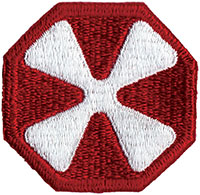
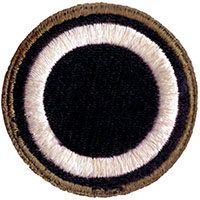
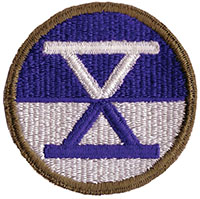

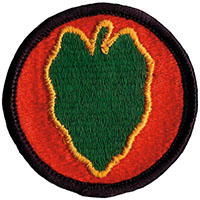
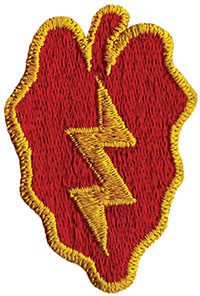


June 1950. The great victory of World War II was still a vivid memory. The demobilization of America’s wartime strength had been accomplished very rapidly. A growing fear of Joseph Stalin’s ambitions was reflected in the new terms iron curtain and cold war, but much energy and hope had focused on such developments as the United Nations, the Marshall Plan, and NATO. Korea, left divided after the war into the Communist North and the U.S.-supported South, was a source of tension but not immediate concern.
The United States was content largely to leave to a UN commission the problem of North Korea’s threatening stance toward South Korea. The Russians had withdrawn their troops from the North in 1948; at the UN’s suggestion, America recalled its troops from South Korea in June 1949, though leaving behind much military materiel and some 500 advisers. In a speech in January 1950 outlining American policy in Asia after the establishment of Communist China, Secretary of State Dean Acheson did not include South Korea within the U.S. “defensive perimeter”; those nations outside that perimeter would have to resist aggression themselves and then rely on the United Nations for support.
At four in the morning on Sunday, 25 June 1950, North Korea launched a full-scale invasion across the 38th Parallel into South Korea. The UN Security Council quickly passed a resolution calling on the North Koreans to cease hostilities and withdraw. When they refused, the Security Council passed a second resolution on the 27th recommending that UN members “furnish such assistance to the Republic of Korea as may be necessary to repel the armed attack and restore the international peace and security in the area.”
Meanwhile, the North Korean forces were advancing rapidly. Seoul, the South Korean capital, would fall by 28 June. These events posed a major challenge to the Truman administration and America’s allies, for if the invasion was not checked, a precedent would be set that could undermine the confidence of countries that relied on the United States for protection. The strength and availability of America’s armed forces, however, had been eroded by such factors as the massive postwar demobilization, uneven and neglected training, antiquated equipment, and, despite improvement, some residual racial segregation.
President Truman did not hesitate. He immediately instructed General of the Army Douglas MacArthur at his Far East Command headquarters in Tokyo, Japan, to supply South Korean forces with ammunition and equipment. On 26 June Truman then authorized MacArthur to use U.S. air and naval units against North Korean targets below the 38th Parallel, and the next day, seizing on the new Security Council resolution, he extended the range of those targets to include those in North Korea. He also authorized the use of U.S. ground forces to protect Pusan, South Korea’s major port. On 30 June, after MacArthur had gone to Korea to assess the situation, Truman authorized MacArthur to use all of his available forces to repel the invasion and blockade the Korean coast.
When the Security Council on 7 July recommended the establishment of a unified command in Korea, under a U.S. commander, Truman appointed MacArthur as Commander in Chief, United Nations Command. Lt. Gen. Walton H. Walker, Commander, U.S. Eighth Army, assumed command of all UN ground forces, which included those of the Republic of Korea. U.S. ground forces available to MacArthur included the 1st Cavalry Division and the 7th, 24th, and 25th Infantry Divisions in Japan and the 29th Regiment on Okinawa. The divisions lacked a third of their infantry and artillery units, and existing units were understrength. Ammunition reserves were low, and training had been sacrificed to occupation duties.
Given the momentum of the North Korean advance and the general unpreparedness of U.S. forces when they arrived, General Walker’s strategy was to gain time through extended defensive delaying actions. The price of engaging the enemy with an inadequate force had been clearly demonstrated in early July when Task Force Smith, flown in from Japan as an advance element of the 24th Division, was attacked and had to retreat with heavy losses of men and equipment. In fighting that grew as fierce as many World War II battles, Walker’s combined UN forces gradually fell back to the south under constant North Korean pressure. But in early August Walker changed the strategy, ordering a final stand along a 140-mile perimeter around the now well-stocked port of Pusan.
With great courage, determination, and adroit movements between defensive positions, Walker’s combined troops held the perimeter into September. At the same time, the Eighth Army’s strength was augmented by mid-August by the arrival of the U.S. 2d Division, the 1st Provisional Marine Brigade, four battalions of medium tanks from the United States, and the 5th Regimental Combat Team from Hawaii. By the end of August a number of South Korean divisions had regrouped, and Great Britain committed its 27th Commonwealth Infantry Brigade from Hong Kong.
The stage was set. Under U.S. Army leadership, the UN force had checked a much larger but now somewhat weakened enemy. With reinforcements in place, General MacArthur by mid-September was ready to go on the offensive.
